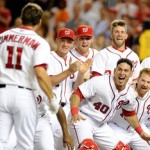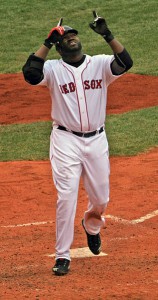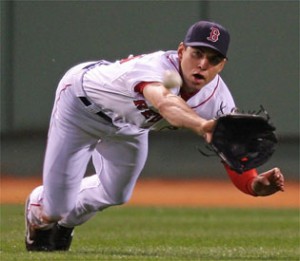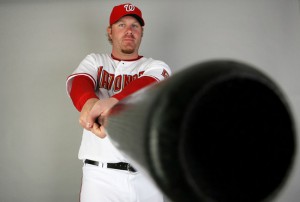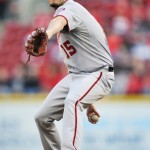
This may be the last time I use Haren’s picture in a Nats uniform on this blog. Photo via Zimbio.com
They say success has many fathers but failure is an orphan. Well, here’s a whole slew of orphan-causing problems that befell this team this year. I started this post months ago, when the team sputtered in July and suddenly sat at 54-60. None of these bullet points are surprises. Maybe I forgot some key points; feel free to tack ’em on. This is a cathartic, washing my hands of the 2013 season, where so many things conspired to go wrongly.
- Davey Johnson, for continued pitching/bullpen mismanagement episode after episode, for seemingly losing the clubhouse (see below), for sticking with severely under-performing players (Espinosa, Haren especially) far, far too long, for failing to react to repeated beanings of his best player, and for generally looking old, tired and out-matched this year at press conference after press conference. This team needs a new voice, a disciplinarian who will command more respect than what Johnson was commanding from this team. My vote is for Matt Williams.
- Injuries. Every team has injuries; I’m not going to write some simplistic statement that says “well if we had So-and-So healthy all year we’d have won the division.” Look at St. Louis: they’re missing Chris Carpenter and Jaime Garcia basically all year and still won the best division in the game. I think the issue most people will have with the Nats is the way their players’ injuries were handled. Bryce Harper missed the whole month of June after several wall collisions finally caught up to him and he was clearly in pain the rest of the season. Did the team not allow him to get healthy at the end of April? Meanwhile you have to take serious issue with either the team, Danny Espinosa or both over the handling of his injuries. What good did it do anyone to allow Espinosa to try to play through the significant shoulder injury he apparently has? Why has he STILL not had the surgery done to fix it? It sounds to me like there’s some serious stubbornness on both sides of this fence. Ross Detwiler looked to be on the verge of a breakout season in 2012 … and now he’s back to being the broken down starter he’s mostly been during his time here. In his 6 pro seasons he’s not pitched full seasons in 3 of them. This isn’t necessarily on the team .. but I will ask this: at what point do you go into a season counting on Detwiler to break down instead of the reverse? It goes to proper roster planning (also mentioned later on).
- Bench production, for regressing so far past the mean from last year’s over production. Did you know that Steve Lombardozzi got more than 300 plate appearances this year with this slash line: .255/.276/.337? I know you need backup utility infielders, but man, that’s a huge 68 OPS+ hole getting a ton of ABs. Our opening-day bench of Lombardozzi/Moore/Bernadina/Tracy posted these OPS+ figures in 2012: 82/123/111/111. In 2013? 69/66/43/55. Wow. That’s just a startling drop-off in production. To add insult to injury Kurt Suzuki‘s OPS+ went from a respectable 95 last year to 64 this year. Basically every pinch hitting spot or guy off the bench covering for a starter turned into an 0-4 outing. We know that at least 3 of these 5 bench guys are gone; who will replace them?
- Dan Haren. $13M for one of the worst starters in the game, even given his little August rebound. The team finished 4 games out of the wild card, 10 games back of Atlanta. In Dan Haren’s 30 starts, the Nats went 11-19. In every other pitcher’s starts, the team went 75-57. That’s a .568 winning percentage, which equates to 92 wins. Even a #5 starter who gave the team a 50/50 chance of winning on any given sunday would have basically put the team into the WC game. Haren was just a really really poor FA acquisition who contributed a huge part to the downfall of the team. I wonder at this point if the Nats didn’t fail to do the proper medical due diligence on Haren; there was a reason the proposed trade to the Cubs fell through and there was a reason the Angels did not give him a qualifying offer. I fully admit: I was completely on board with the signing, thinking we were getting the pre 2012 Haren. Wrong; something clearly changed for him after the 2011 season and I wonder how much longer he can stay in the league after his last two seasons. I’m sure he’ll get another one-year deal for 2014 based on his stronger finish, but another 5+ ERA season may finish him.
- Offense in general: The team scored 656 runs on the year. That’s down fully 75 runs from last year, when they were 10th in the league in scoring. Had they produced like they did last year in 2013 (about 10th in the league in runs scored and other key indicators), they’d have scored around 700 runs, probably good for at least 10 more wins (under the rough estimate that it takes about 4 “extra” runs per win). With 10 more wins … they’re winning the division again (since some of those added wins come at the hands of Atlanta).
- Hitting in the Clutch: Ask any sabre-nerd and they’ll tell you that “clutch” doesn’t exist and that all aspects of batting (good or bad) with RISP is merely coincidence (this came up again recently with David Ortiz’ game-changing NLCS homer). I don’t entirely buy it. I think hitting with runners on base is a skill that can be practiced and honed. I think there’s importance to driving runners in when you have the opportunity. I think a batter with a runner on third and less than one out can absolutely look for a ball that he can hit into the air, thus driving in the run. Anyway: let’s look at how well the Nats offense hit in the clutch this season (see this team-stats split link at tFangraphs). The Nats team batting average with runners on base is ranked 19th in the league; its wRC+ as a team 17th. However, change “runners on base” to “high leverage” in the Fangraphs split and you get this: Nats were 29th in high leverage batting average, 28th in wRC+. That’s right: almost dead last in the league in high-leverage hitting for the year. When they came to bat in situations that mattered, they were one of the worst teams in the league. Any way you slice it … that’s not “clutch.”
- Clubhouse Issues: I know that many readers here get irritated with presumptions of “chemistry” issues, writing comments about how we have no idea what really goes on in the clubhouse. Fair enough; we don’t need to rehash the argument. Absent any proof, I believe something might have been amiss. Reporters have noted the losses of free-spirit Morse and the level headed DeRosa. The Soriano acquisition brought a known surly loner with behavior problems into a tight knit bullpen and resulted in the chain reaction demotion of two guys (Storen and Clippard) who didn’t necessarily deserve to be demoted. I believe Harper was fed up with Johnson’s message and was caught on camera more than once clearly ignoring or showing disdain to something he was being told. To say nothing of the ridiculousness of Harper getting hit over and over without any of his teammates getting his back. Can a new manager fix this? Probably. Can a leadership void fix this? Definitely. Perhaps with Jayson Werth‘s great season he can step up in the clubhouse and be the voice of reason moreso than it seems he has been before (either because he was struggling on the field or collapsing under the weight of his contract).
- Rizzo’s mis-management of the 2013 roster: Rizzo just had to have his speedy leadoff/centerfielder, and Span underperformed when it counted (I’m on record stating over and over that the team is wasting Harper’s defensive capabilities in left and blocking a power-hitter acquisition by sticking with Span in center. But what’s done is done). The opening day roster had no left handed specialists, a move that I quasi-defended at the time but which turned out to be disastrous. We relied on a MLFA (and frankly, we over-relied an incredibly short sample size) for the long man (Duke) and he failed. We had absolutely no starting pitching depth in the high Minors and got rather lucky that Taylor Jordan materialized out of the thin air of high-A and Tanner Roark suddenly added 5 mph to his fastball and turned into an effective MLB hurler. We had a $120M payroll but were depending on bargain basement acquisitions in key roles. That just has to change for 2014. Don’t go looking to save pennies on the proverbial dollar by non-tendering useful guys (as they did with Tom Gorzelanny last year); do the right thing and lock these guys up. You had enough to waste $30M on Soriano but couldn’t find the scratch to keep around half of 2012’s bullpen?
- Pressure. this team had no pressure last year, and all of the pressure this year. Nearly every baseball pundit with a blog, microphone or column picked them to win the division (me included), and lots picked them to win 100+ games (me included). Look at how awfully they fared this year against the NL playoff bound teams:
- Stl: 0-6, scoring just 8 runs in 6 games.
- LA Dodgers: 1-5
- Atlanta: 6-13. Outscored 73-49
- Pittsburgh: 3-4
- Cincinnati: 4-3 but outscored 36-27 thanks to a 15-0 spanking the 2nd week of the season.
When the chips were down, they folded. Especially against Atlanta, who pushed the team around, continually threw at us, and we had no reaction (that is until Strasburg suddenly had a fit of wildness which some will argue was less about standing up for his players and more about being off that day). I lay this at the manager’s feet again. Atlanta has proved time and again (and again) that they’re capable of acting like bullies when it comes to “unwritten rules” of the game, and Johnson let this go unchecked far too long. A new manager with some balls will put an end to this nonesense, fast. Sorry to sound crude, but it is what it is. Johnson had no balls and made his entire team look weak in the face of the Braves.
Yes its great the team had a run in August and September. What does it really mean? Their schedule was cake in August and then filled with teams with AAA callups in September. Who is the real Denard Span? The guy who hit .235 in the middle of the summer or the guy who hit .303 in September? Can Werth keep this kind of production up in the face of father time in 2014? Can LaRoche return his OPS to something better than what a middling 2nd baseman can produce? Can Harper stop running into walls and stay on the field?
I think the scarier part for Nats fans is the fact that this team is basically going to be the exact same team next year. Nearly every position player, likely the entire rotation (simply replace Haren with a healthy Detwiler), most all of the bullpen. There’s not a lot of holes here, not a lot of wiggle room. Unless there’s a major trade on the horizon that drastically reshapes the roster, this is your team in 2014. Can they turn it around and make up the 14 games they declined in the win column?
In summary; which of the above points IS the real issue behind 2013’s disaster? And how do you fix it? Because if you don’t address it, then 2014 is going to be the same story.
